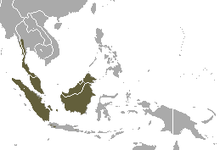Banded linsang
| Banded linsang | |
|---|---|

| |
| Scientific classification | |
| Domain: | Eukaryota |
| Kingdom: | Animalia |
| Phylum: | Chordata |
| Class: | Mammalia |
| Order: | Carnivora |
| Suborder: | Feliformia |
| Family: | Prionodontidae |
| Genus: | Prionodon |
| Species: | P. linsang[1]
|
| Binomial name | |
| Prionodon linsang[1] (Hardwicke, 1821)
| |

| |
| Banded linsang range | |
The banded linsang (Prionodon linsang) is a linsang, a tree-dwelling carnivorous mammal native to the Sundaic region of Southeast Asia.[2]
Description
[edit]The banded linsang grows to 35–41.1 cm (13.8–16.2 in), with a long tail that can reach 36.2 cm (14.3 in).[3] It is a pale yellow with five dark bands. The average weight is around 700 g (25 oz). It has broad stripes on its neck and its tail consists of several dark bands with a dark tip. The tail has seven or eight dark bands and ends in a dark tip. The banded linsang has very sharp retractable claws.[4]
Distribution and habitat
[edit]The banded linsang has been recorded in southern Myanmar, Thailand, Peninsular Malaysia, and the Sunda Islands of Borneo, Sumatra, Java, Bangka and Belitung Islands. It lives in evergreen forests. In Thailand and Malaysia it has been recorded in deciduous forest, and in Sarawak also in secondary forest and close to oil palm plantations.[2]
In 2013, a banded linsang was recorded for the first time by a camera-trap in the hill forests of Karen State.[5]
Ecology and behaviour
[edit]The banded linsang is nocturnal and usually solitary.[6] It is carnivorous, with its diet consisting of small vertebrates, such as birds, rats, and snakes.[3]
Very little is known about the banded linsang's reproduction. It is thought that litters of 2–3 are born semiannually in a nest in burrows or hollow trees.[7]
Taxonomy
[edit]Until recently the two species of Asiatic linsangs were considered to be members of the family Viverridae and to be related to the morphologically similar genets. However, recent genetic taxonomy investigations have strongly suggested that the Asiatic linsangs are a sister-group of the cat family, Felidae. It has been proposed that the Asiatic linsangs be placed in the monogeneric family Prionodontidae.[8]
References
[edit]- ^ Wozencraft, W. C. (2005). "Species Prionodon linsang". In Wilson, D. E.; Reeder, D. M. (eds.). Mammal Species of the World: A Taxonomic and Geographic Reference (3rd ed.). Johns Hopkins University Press. pp. 532–628. ISBN 978-0-8018-8221-0. OCLC 62265494.
- ^ a b c d Duckworth, J.W.; Mathai, J.; Chutipong, W.; Brodie, J.; Wilting, A. (2016). "Prionodon linsang". IUCN Red List of Threatened Species. 2016: e.T41705A45219711. doi:10.2305/IUCN.UK.2016-1.RLTS.T41705A45219711.en. Retrieved 24 January 2022.
- ^ a b "Banded Linsang". Wildlife Conservation Society Indonesia. Retrieved 12 February 2019.
- ^ "Prionodon linsang - banded linsang". Animal Diversity Web.
- ^ Saw Sha Bwe Moo; Froese, G.Z.L. & Gray, T. N.E. (2017). "First structured camera-trap surveys in Karen State, Myanmar, reveal high diversity of globally threatened mammals". Oryx. 52 (3): 537–543. doi:10.1017/S0030605316001113.
- ^ Jennings, A.P. & Veron, G. (2015). "Predicted distributions, niche comparisons, and conservation status of the Spotted Linsang (Prionodon pardicolor) and Banded Linsang (Prionodon linsang)". Mammal Research. 60 (2): 107–116. doi:10.1007/s13364-014-0204-y. S2CID 17396993.
- ^ Whitfield, P., ed. (1984). "Civets". Macmillan Illustrated Animal Encyclopedia. Macmillan Publishing Company. p. 92. ISBN 978-0-02-627680-1.
- ^ Gaubert, P. and Veron, G. (2003). "Exhaustive sample set among Viverridae reveals the sister-group of felids: the linsangs as a case of extreme morphological convergence within Feliformia". Proceedings of the Royal Society, Series B, 270 (1532): 2523–2530. doi:10.1098/rspb.2003.2521
External links
[edit]- Banded linsang media from ARKive
Text is available under the CC BY-SA 4.0 license; additional terms may apply.
Images, videos and audio are available under their respective licenses.

